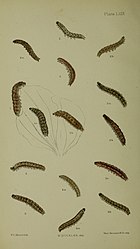Hoplodrina blanda
| The rustic | |
|---|---|

| |
| Scientific classification | |
| Domain: | Eukaryota |
| Kingdom: | Animalia |
| Phylum: | Arthropoda |
| Class: | Insecta |
| Order: | Lepidoptera |
| Superfamily: | Noctuoidea |
| Family: | Noctuidae |
| Genus: | Hoplodrina |
| Species: | H. blanda
|
| Binomial name | |
| Hoplodrina blanda (Denis & Schiffermüller, 1775)
| |
Hoplodrina blanda (the rustic) is a moth of the family Noctuidae. It is found in the Palearctic realm (Europe, Morocco, Iran, Russia – south Urals, and southwest Siberia).
Technical description and variation
[edit]The wingspan is 31–35 mm. The length of the forewings is 13–16 mm. Forewing fawn-tinged grey, with a fuscous suffusion, with the ground colour sometimes paler, more luteous ochreous, especially in examples from W. Turkestan; costal edge pale; inner and outer lines obscurely marked; the median and praesubmarginal shades distinct; stigmata fuscous grey, with pale annuli; hindwing whitish, grey-tinged towards termen; the veins and cell mark darker; altogether darker grey in the female. Occurs throughout Northern and Central Europe and in Central Asia. These Asiatic examples — from Issyk-Kul; the defile of Little Kisil-su, Tianshan; Kappak, Alexander Mts.; and Ketmen-tjube, Sussamyr Mts.; must be separated certainly as an ab. centralasiae ab. nov. [Warren] though very possibly a distinct species; the ground colour of the forewing is paler, tinged with pinkish brown along the two folds, and the dark markings stand out more conspicuously; the costal edge is pale; the hindwing, even in the female, is whiter, showing a distinct cell spot. Described from a series of more than a dozen males but only one female, from the above-mentioned localities; the type male from Kappak, the female from Ketmen-tjube.[1] Similar to and confused with Hoplodrina octogenaria and Hoplodrina ambigua. Certain identification requires dissection of the genitalia.See Townsend et al.[2]

Biology
[edit]The moth flies in one generation from late May to early September. [1].
Larva ochreous with red or brown suffusion and dotted with dark; dorsal line yellowish edged with small black marks; subdorsal lines pale, dark-edged below; head pale marked with darker: on sundry low plants. The larvae feed on herbaceous plants such as Plantago, Stellaria and Rumex.[3]
Notes
[edit]- ^ The flight season refers to Belgium and the Netherlands. This may vary in other parts of the range.
References
[edit]- ^ Seitz, A. Ed., 1914 Die Großschmetterlinge der Erde, Verlag Alfred Kernen, Stuttgart Band 3: Abt. 1, Die Großschmetterlinge des palaearktischen Faunengebietes, Die palaearktischen eulenartigen Nachtfalter, 1914
- ^ Martin C. Townsend, Jon Clifton and Brian Goodey (2010). British and Irish Moths: An Illustrated Guide to Selected Difficult Species. (covering the use of genitalia characters and other features) Butterfly Conservation.
- ^ "Robinson, G. S., P. R. Ackery, I. J. Kitching, G. W. Beccaloni & L. M. Hernández, 2010. HOSTS – A Database of the World's Lepidopteran Hostplants. Natural History Museum, London".
External links
[edit]- The Rustic at UKmoths
- Funet Taxonomy
- Fauna Europaea
- Lepiforum.de Includes photo of slide-mounted genitalia
- Vlindernet.nl (in Dutch)
